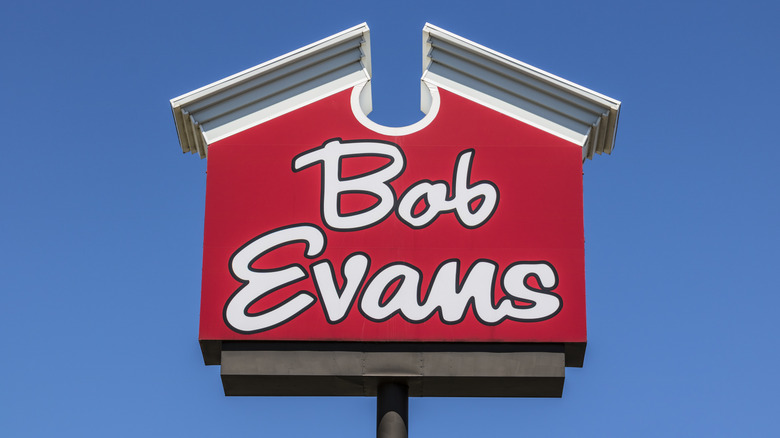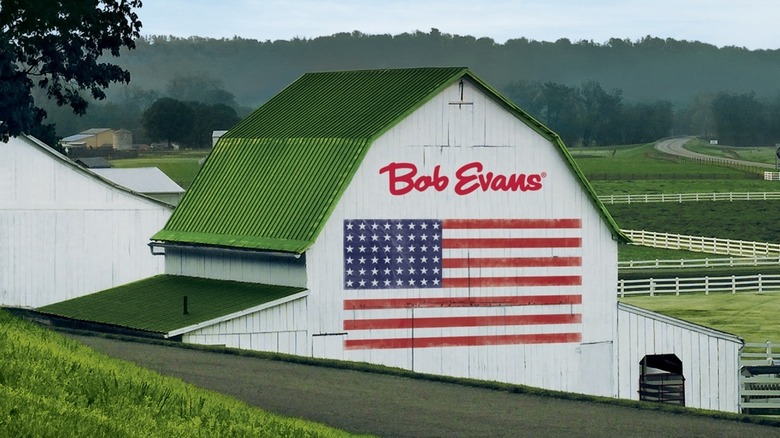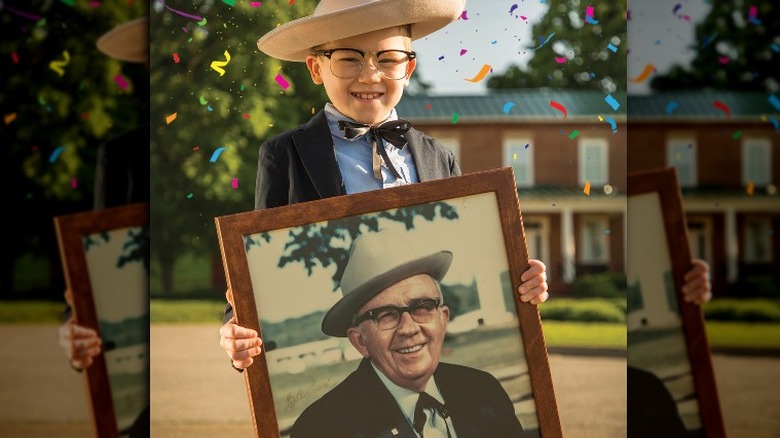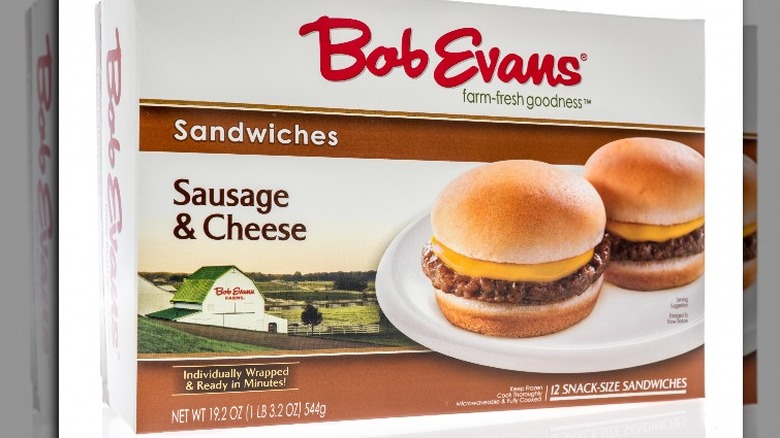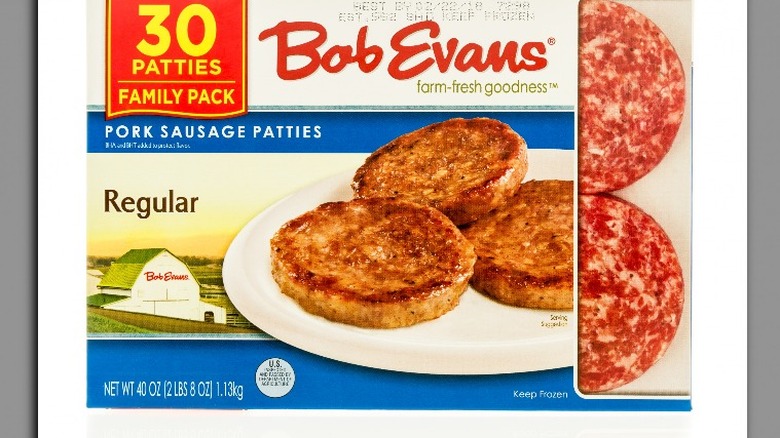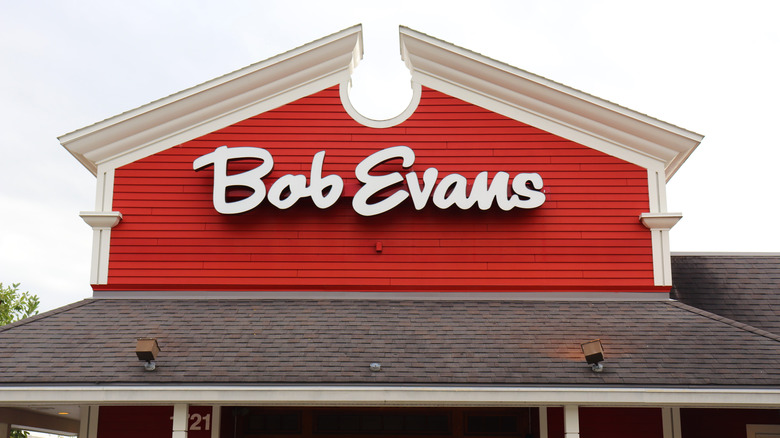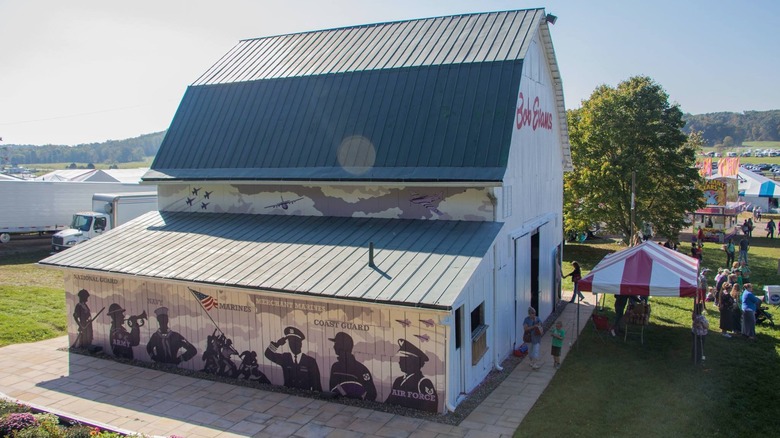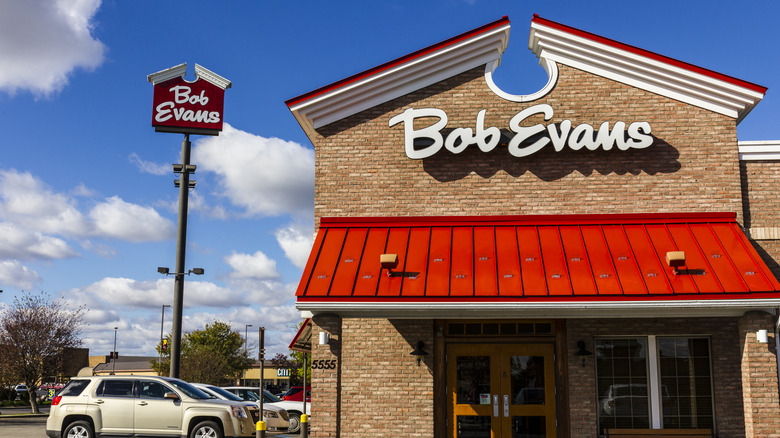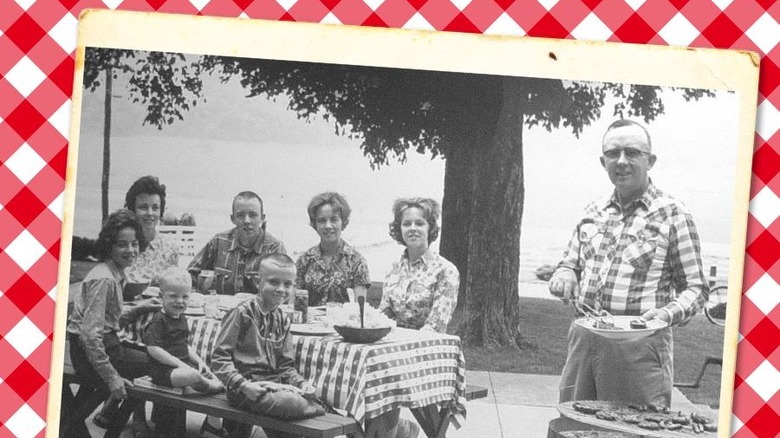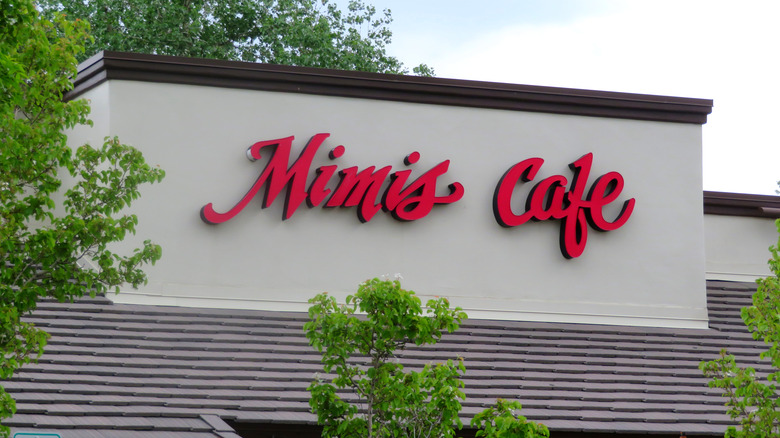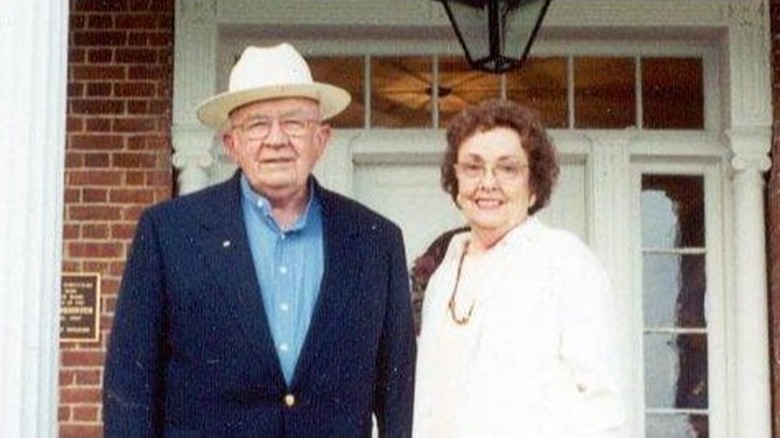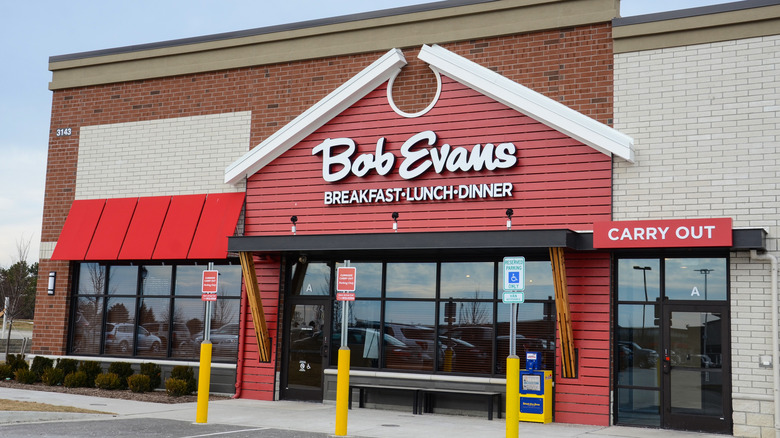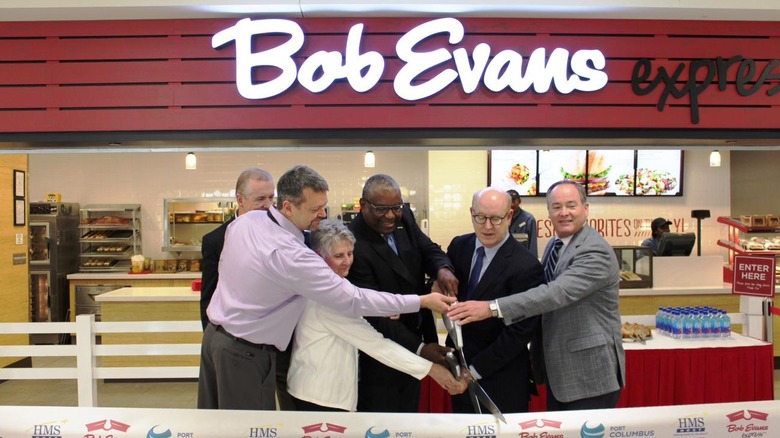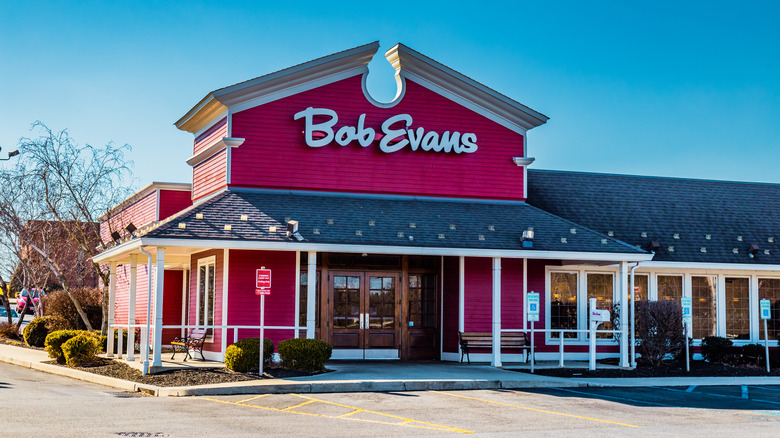The Untold Truth Of Bob Evans
Maybe the farmhouse-style, red restaurant is one of your favorite chain breakfast spots or your top pick for fueling up during a road trip. Maybe you love the grocery store food items, like the microwavable mashed potatoes or mac 'n cheese. Whatever reason you're a fan of Bob Evans, there's likely a lot that you don't know about the popular brand. Like, did you know that Bob Evans was a real guy, a farmer in Ohio? And did you know that, unlike many food brands that start with a restaurant first and add branded grocery store items later, Bob Evans actually started out selling sausage? Did you know there's a Bob Evans tourist attraction in Ohio, too?
From Bob Evans' humble roots on a family farm in Appalachia to its expansive empire stretching over nearly 20 states, with nearly 500 restaurant locations, here's the untold truth of the Bob Evans brand.
The first Bob Evans restaurant was a 12-stool diner-meets-steakhouse
The very first Bob Evans restaurant wasn't the red-sided Bob Evans you see today (via Funding Universe). Instead, it was an itty-bitty restaurant known as Bob Evans Steak House, opened in 1946 by Bob Evans the man (who we'll get to in a moment). The restaurant, situated in Gallipolis, Ohio (a small village along the river border that separates Ohio from West Virginia), was kind of a diner-meets-steakhouse, rather than a steakhouse in the traditional sense, as you might expect from the name. Instead of white tablecloth service, the restaurant offered 12 diner-style stools. Instead of dinner-only service, the restaurant was open 24 hours, with a special focus on its breakfast offerings. The clientele? Lots of truck drivers.
The first Bob Evans restaurant that looked anything like what you might see today didn't open until the late 1960s, more than two decades after the first restaurant opened its doors.
Yes, Bob Evans was a real person
So who was the real Bob Evans? Born in 1918, Bob Evans, according to his 2007 obituary, was a farmer, restaurateur, and opinionated businessman and entrepreneur. He opened that first diner-meets-steakhouse restaurant in Gallipolis after World War II, just a short drive from his family farm in Rio Grande, Ohio. There, he and his wife, Jewell, raised six kids (via Funding Universe). Evans pushed his self-named brand from small restaurant concept to sausage brand to national restaurant chain, remaining involved in the business until his retirement in 1986.
Evans credited his success in part to the farmer persona he kept up all throughout his career (he could often be seen wearing a Stetson hat and string tie). He said, "People like to deal with farmers. They like to buy stuff from the farm. They think it's fresher. In their mind, it's better and they're willing to pay more for it."
Bob Evans' claim to fame was sausage, and its biggest fans were truck drivers
While Bob Evans was operating the Bob Evans Steak House in Gallipolis, he ran into a consistent problem: He could never get high-quality breakfast sausage from his suppliers. As Evans is quoted on the brand's website, "We served a lot of breakfasts, but we couldn't get any decent sausage. So I decided to start making my own from hogs raised right on our farm, using all the best parts of the hog, including the hams and tenderloins."
Equipped with a thousand dollars, several pigs, 40 pounds of black pepper, and 50 pounds of sage, Evans' obit explains, he was able to turn out a product that quickly became a hit with the restaurant's clientele, especially the truck drivers, who would purchase the raw sausage in bulk to take home in 10-pound tubs. "You might say the truck drivers did my research for me," Evans said. "They would tell me that this was the best sausage they ever had ..."
Bob Evans' sausage success led to the initial sausage brand, which became before the restaurant
Many restaurants eventually branch out into grocery stores with items designed to mimic what you'd order off a menu (such as the freezer items you'll find offered by brands such as TGI Friday's). However, Bob Evans went the other way around. Seeing his sausage success, Evans decided to start selling the stuff in bulk not only to truckers, but also to other restaurants and locally-owned stores, delivering the sausage himself in his pickup truck (via Legacy). According to the brand, he then built a processing facility for the sausage on his Rio Grande farm, but was still ever-cautious, building the processing facility in such a way that it could be converted into farm storage if the sausage business ever failed.
As his popularity grew, though, and it became apparent that the sausage business would not fail anytime soon; Evans began inviting his buyers out to the farm to see where and how the sausage was made. In 1953, when a group of friends and family visited to see the same, they encouraged him to expand the business even further (via Funding Universe). In the mid-1950s, with a few business partners and a new, larger packing plant, Bob Evans Farms Sausage incorporated and began shipping sausage all throughout central and southern Ohio.
The sausage business's success led to the founding of the first "official" Bob Evans restaurant
When Bob Evans turned his attention fully to the sausage business, as you might expect, Bob Evans Steak House fell to the wayside. However, Evans wasn't done with the restaurant business quite yet. As more and more visitors made their way to the farm, which quickly became known as the Homestead, Evans decided to open another small, 12-stool restaurant, this one christened The Sausage Shop, in 1962 (via Bob Evans).
The Sausage Shop was successful, so, in 1968, the brand, at this time quickly spreading its influence across the Midwest, publicly owned and with shareholders to please, decided to open the first Bob Evans restaurant. According to Funding Universe, the pilot restaurant was situated in Chillicothe, Ohio, about an hour away from Rio Grande and Gallipolis. While the farmhouse-style design of the restaurant was reminiscent of what you might see today, the original menu was not, serving fast food-esque burgers and fries; the brand quickly saw the error of its ways, though, and changed the menu to include hearty, country-style fare.
After the firm establishment of the successful Bob Evans restaurant chain, the Sausage Shop was renamed Bob Evans as well, and expanded, from its 12 seats to what is now more than 100 seats.
Today, the original Bob Evans farm is a tourist attraction
The original Bob Evans farm, now known as the Bob Evans Homestead, is a popular tourist attraction in Rio Grande, Ohio. According to Tourism Ohio, the site, which boasts National Register of Historic Places status thanks to its even earlier history as a stagecoach stop and inn, offers a range of activities for visitors to enjoy, beyond simply stopping at the flagship restaurant. There's a company museum and history center, plus tons of historically significant spots on the property that would be of interest to history buffs even if the Bob Evans brand had never grown famous — think a Revolutionary War cemetery, Native American burial ground, and reconstructed historic structures such as an old schoolhouse and cabins.
The Homestead also hosts the Bob Evans Farm Festival every year, which draws thousands of attendees, and is basically like a county or state fair in miniature. Activities include farming demonstrations, clogging competitions, lumberjack shows, pig racing, and more.
Today, all Bob Evans locations are company-owned, with no franchises
A next step for many successful, growing restaurants is franchising. Franchising has been an important part of growth for many a national or regional chain. However, the Bob Evans brand owns all of its locations, with no franchising allowed. There are a few reasons for this. According to Columbus Business First, when a restaurant actively owns the land that its restaurant sits on, it makes it easier to conduct business and also close a restaurant if needed; it also prevents issues like climbing rents. Franchising, a restaurant analyst told the publication, could cause the brand potential harm, down the road (though it wasn't specified what exactly that harm could be).
Bob Evans did, however, offer franchising for its Bob Evans Express shops (more on those in a bit), in 2013. While it was speculated that the decision to license the smaller eateries could've been a test to see how franchising might work out for the brand in the future, that assumption was never realized.
The real Bob Evans retired in 1986, but remained active in philanthropy, with a focus on farming
The real Bob Evans stayed active in the Bob Evans businesses, both the food and restaurant sides, until his retirement in 1986. Even after his retirement, he stayed active in the Rio Grande region, focusing on farm-related philanthropy efforts. According to Ohio History Central, Evans would actively promote environmentally-friendly and efficient farming techniques to local farmers, and financially supported agriculture-focused youth groups like 4-H and the Future Farmers of America. He was the first-ever lifetime member of the Ohio 4-H Foundation Board, says Appalachian Ohio, and was the organization's first-ever I'm a Child of Appalachia honoree, a program that promotes Appalachian youth access to college educations.
Today, the Bob Evans brand carries on Evans' spirit of giving back, with various philanthropic efforts, such as the Bob Evans Harvest Program, which partners with Food Donation Connection to donate extra food and ingredients to local food banks and related charities near restaurant locations. To date, the program has donated nearly 4 million pounds of food in total, or about 10,000 pounds of food per Bob Evans location.
Over the years, Bob Evans acquired several other food and restaurant brands
As Bob Evans grew from small restaurant chain in the 1960s, to a nationwide brand, it acquired several other brands, both sausage brands and regional restaurant chains (via Ohio History Central). Acquired restaurant chains included Mimi's Cafe Restaurants and Owens Restaurants. The former (now known as Mimi's Bistro + Bakery and found primarily in California) was acquired in 2004 and served a French and New Orleans-style menu. The latter was part of the larger purchase of the connected Owens Country Sausage brand, in 1987, for $15.9 million (via the Chicago Tribune).
By 2004, Bob Evans owned more than 500 restaurants, but it did eventually sell off the Mimi's brand, while closing all Owens locations. In 2013, Bob Evans sold the Mimi's Cafe chain to Le Duff America, Inc., for $50 million, according to Baking Business. In 2006, it sold all remaining Owens Restaurants locations, though it retained Owens Country Sausage, according to Fast Casual.
In the 1990s, Bob Evans tried out a Mexican restaurant concept, which the founder called a disaster
As Bob Evans' obituary notes, there was one time that he was pretty vocal about the Bob Evans brand and the direction it was heading following his retirement. In 1991, Bob Evans decided to go after competitor Chi-Chi's with a new Mexican restaurant concept called Catina del Rio (via the Chicago Tribune). A pilot, 300-seater restaurant was planned for Columbus, Ohio, where the brand was also to be headquartered. While, ahead of the initial launch, decision-makers were optimistic enough about Cantina del Rio to plan additional, following locations elsewhere in Ohio, the brand didn't take off.
In a 2003 interview, Evans called the Cantina del Rio concept "a disaster" and complained about not being consulted for some of the brand's acquisitions, but, by the time of the interview, he indicated that he was once again happy with the direction of the brand's growth, saying, "They're doing a pretty good job. They got rid of all those dogs."
In 2009, Bob Evans revamped its look for the modern era
In 2009, the Bob Evans brand was due for a refresh, which came in the form of revamping its restaurants to more closely resemble the Homestead in Rio Grande, Ohio, only more "contemporary and relevant" (via Syracuse.com). In addition to changing the architecture and interior design to keep up with the modern era, the brand also decided to redesign staff uniforms at the time, as well as start offering free WiFi in dining rooms, and even charging stations, with outlets at tables. New dining rooms would also start featuring communal dining tables, tables that were easier to rearrange to meet restaurant needs, and flat-screen televisions. At the time of the revamp, a new service also began — curbside carry out, to better compete with other sit-down restaurants offering similar services.
While the changes were all certainly contemporary, they drew some criticism, with some noting that the more modern touches, such as the charging outlets and high-definition televisions, somewhat detracted from Bob Evans' country-esque vibe for which it had become known.
At the time of the changes, Bob Evans boasted nearly 600 units.
In 2013, Bob Evans opened a new quick-service variant: Bob Evans Express
After pushing through with its revamps in 2009, Bob Evans continued on with the launch of a new restaurant concept and its first franchise opportunity. Bob Evans Express was a quick-service variant of the real deal, with a small footprint suitable for food courts (via Columbus Business First), and not just food courts in malls; Bob Evans also looked to open Bob Evans Express locations in factories and manufacturing plants, hospitals, and airports. Two of the quick-service restaurants opened in 2013, followed by a handful of others soon after.
The Bob Evans Express model offers counter service with a cooler for customers to grab their own drinks and select sides, and then an employee dishes out baked items and popular entrees and side dishes from a visible hot food station. Reviews of the Bob Evans Express location at John Glenn Columbus International Airport vary and range from "simple but tasty" to "the sold [sic] saving grace is that it's very, very affordable for airport food."
Most recently, in 2017, Bob Evans found two new homes
Despite the Bob Evans long history of success, the brand was ready to sell off its packaged foods division in 2017, when it entered into an agreement with Post Holdings to sell Bob Evans Farms, Inc., at $77 per share. According to a press release from Post Holdings, the idea was that Bob Evans' grocery store items, from the iconic sausage to the microwavable breakfast sandwiches, would be a nice complement to Post's other offerings (which you likely know as the many, many different Post cereals). The equity value of the transition? A none-too-shabby $1.5 billion.
However, the deal wasn't the first for Bob Evans that year. Prior to the sale of Bob Evans Farms, Inc., in January 2017, Bob Evans Farms, Inc. sold off Bob Evans Restaurants to Golden Gate Capital, for $565 million (via Nation's Restaurant News). The private equity firm was a natural fit for the restaurant chain, as it also acquired Red Lobster in 2014, and, at the time, owned California Pizza Kitchen. The restaurant sale came at the encouragement of large shareholders, who'd already been pushing for major changes for the sake of profitability.
For 2021, Bob Evans has projected $780 million in sales, a "somewhat historic number," as FSR Magazine reported, crediting the brand's most recent success to improvements that were years in the making, including simplifying menus and partnering with delivery services like DoorDash.
